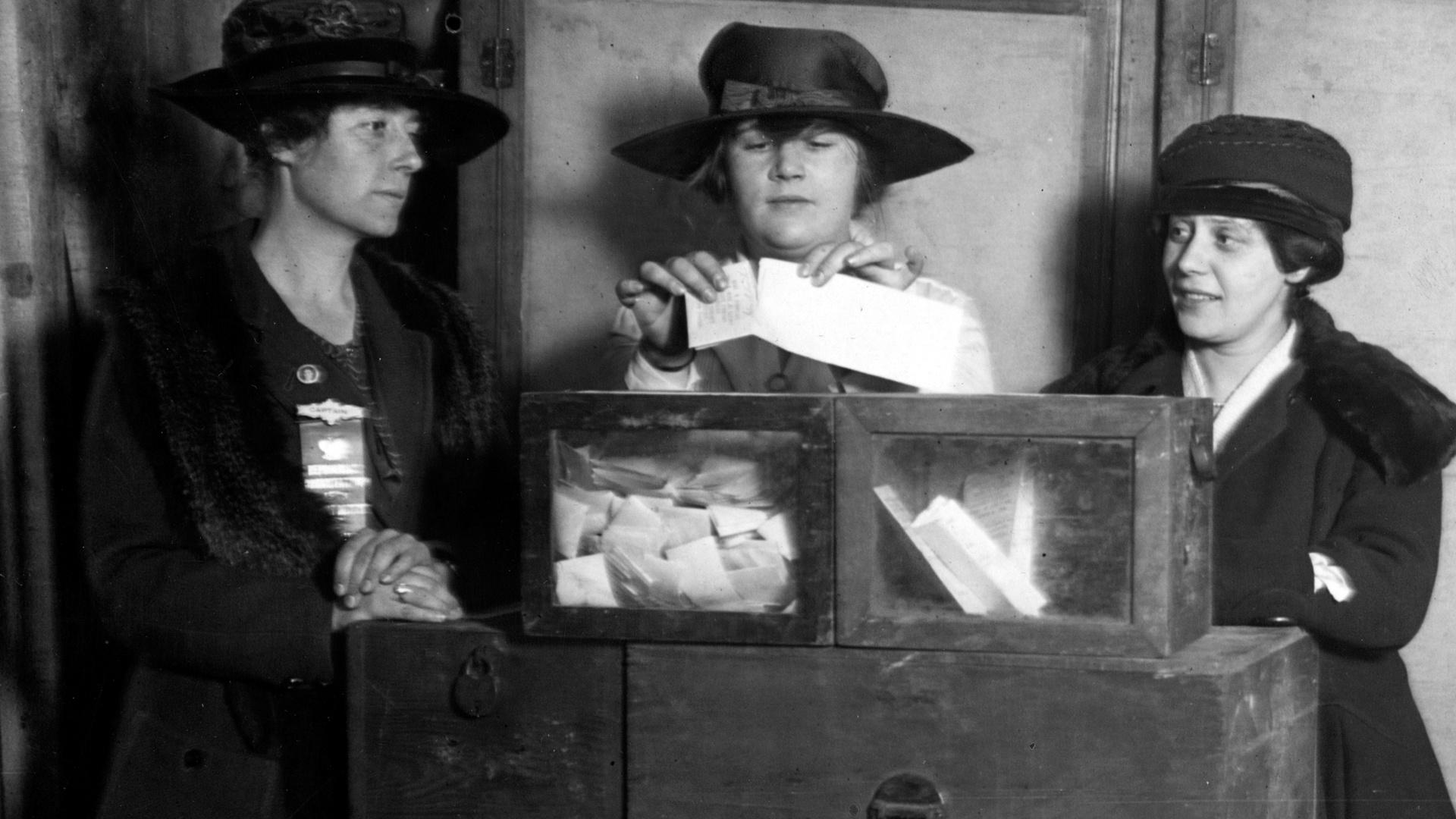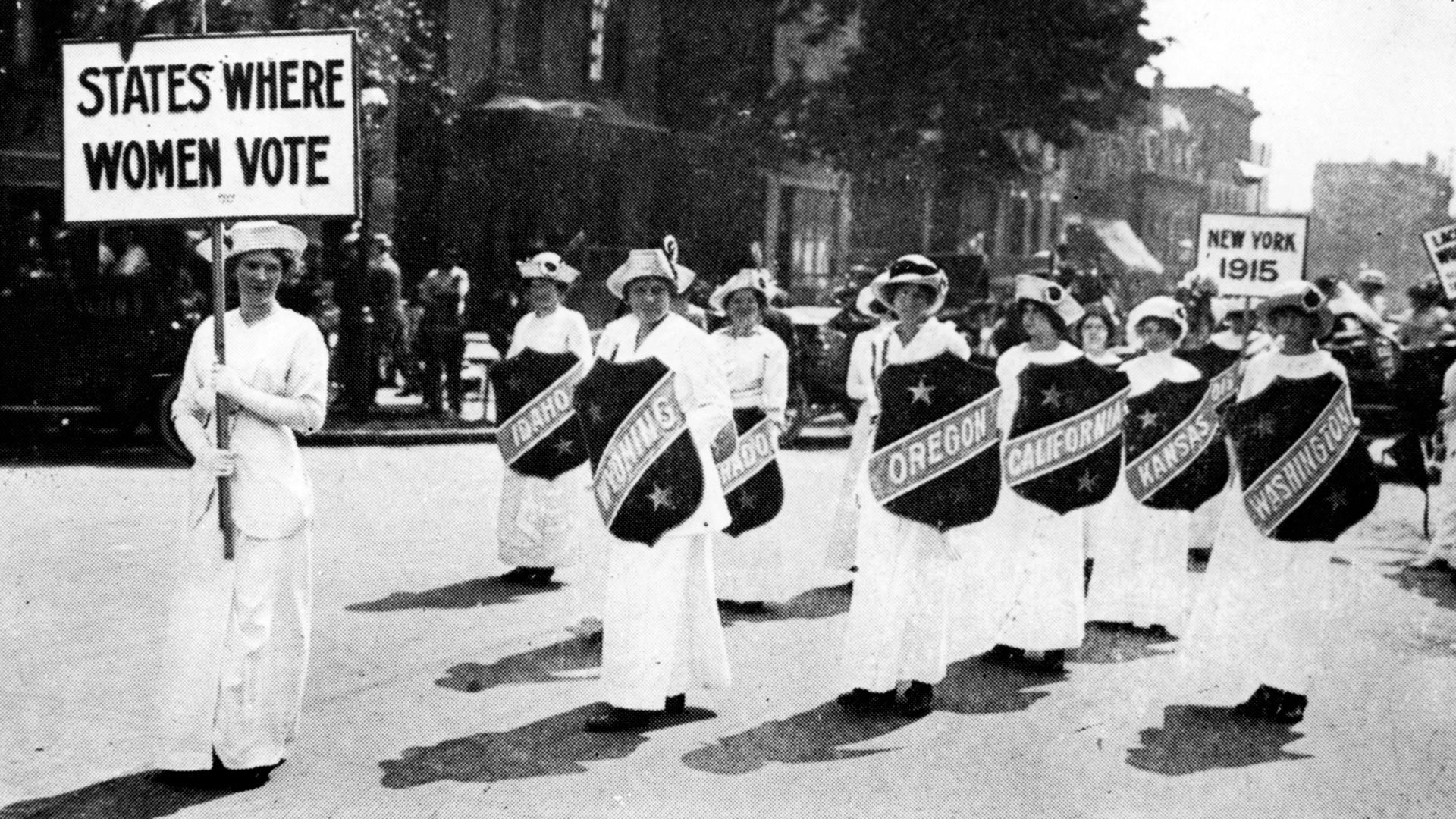
The Centrality of New York State in the Women’s Suffrage Movement
by Susan Goodier, Ph.D.
Assistant Professor, SUNY Oneonta
As I write this, 2020 is drawing to a close. This is the year that many of us who study the Women’s Suffrage Movement had been looking forward to. It marks the centennial of the 19th Amendment enfranchising women across the nation. Although it became a year entirely different from what we anticipated, there is still great cause for celebration and much that we can learn from the outpouring of publications and documentaries on various perspectives of the movement for women demanding, and ultimately obtaining, the right to vote. If anything, we have gained an understanding of just how complicated the movement to gain the right to vote for one-half of the citizens of the democracy was. It was, and to a great extent, still is a movement centered primarily in New York state, hard-fought, yet with far-reaching gains for women.

New York, with its large and diverse population, has a history of nurturing many activist movements. Its people offered great leadership, experiments in expanded property and civil rights, and influential evidence for the reforming power of coalitions that transcended barriers to achieve incredible change for women. Native American women had greater rights within their communities long before contact with Europeans. Despite the American Revolution's powerful rhetoric of equality, non-Native women, Black and white, remained peripheral to the rights and privileges of democracy for another century and a half.
New York women have always involved themselves in movements that demanded greater equality for the people of the state. During the early 19th century, women learned much about citizenship and equality from their involvement in interconnected social movements. Many women found problems to solve in their communities, building brick and mortar institutions to harbor the poor, destitute, and suffering children, widows, and others who needed help. Many saw the institution of slavery as a great evil and sought its abolition. Paulina Wright Davis and several others fought to end slavery, as well as temperance, women’s property rights, and suffrage.
The diversity of the population of New York has long been its greatest asset. The Erie Canal, built between 1817 and 1825, drew immigrants from Europe to dig the waterway and construct locks stretching from Albany to Buffalo. Their families often remained in New York following its completion and contributed to the development of the state in other ways. The canal and its several subsidiary canals formed convenient pathways for the transmission of ideas including religious ideology, spiritualism, concern for those less fortunate, temperance in the consumption of alcohol, the expansion of legal, civil and political rights, the ending of slavery, and expanded rights for women. Women and men living in communities along the canal avidly listened to speakers who could now easily traverse the state, spreading democratic values along the way.
Anti-slavery advocacy accompanied the religious fervor spread along the canal. In 1799, John Jay, then governor of New York, put into place a process of gradual emancipation for enslaved people in the state. For those born into slavery after July 4, 1799, women would owe 25 years of labor to their masters, and males would owe 28 years. However, not all New Yorkers believed in ending slavery nationwide. When Paulina Wright Davis and her husband helped organize an anti-slavery convention in Utica in 1835, they faced an angry crowd. Even in that otherwise enlightened and prosperous city situated on the Erie Canal, calls for abolition forced Davis and her colleagues to relocate their convention to the safety of Gerrit Smith's estate 30 miles away in Peterboro, NY.
We might think that Davis represents most women of her day, but she does not. Often bound to isolated rural homes with childcare responsibilities, women rarely challenged the system already in place. Although they may have privately expressed frustration at the limits women faced, it requires uniquely bold women to dare to oppose social standards, legal mandates, and deeply ingrained customs to pursue dramatic changes in societal gender norms. Davis, like most of the women we celebrate today as women’s rights activists, battled social condemnation and barriers throughout their careers.
Paulina Wright Davis did not attend the 1848 Women’s Rights Convention in Seneca Falls, NY, another important community on the Erie Canal. But 300 women and men did, eventually prompting radical changes in the place of women in the nation. Organized by Lucretia Mott, Jane Hunt, Martha Coffin Wright, Mary Ann M’Clintock, and Elizabeth Cady Stanton, the convention debated the Declaration of Sentiments and its resolutions demanding the expansion of women’s rights in public, in church, and before the law. Frederick Douglass, who traveled from his home in Rochester, NY to attend the convention, published reports of the convention and supported women’s rights his entire life. At first, women’s rights activists decided not to officially organize a movement, but held conventions, mostly in New York (every year but 1857), to discuss strategies for expanding women’s rights. During the American Civil War (1861-1865), these activists focused their attention on supporting the Union's cause and demanding an end to slavery. After the war, the Reconstruction Amendments — the 13th ending slavery, the 14th making citizens of formerly enslaved males, and the 15th granting those men the right to vote — caused deep rifts in formerly close-knit activist communities in New York.
At the first women's rights convention held after the war, attendees founded the American Equal Rights Association to pursue universal suffrage. Although the membership included activists from the abolition and women’s rights camps and welcomed Black and white women and men, they struggled to agree on the best strategies to win their objective. In the winter of 1867, several Black and white members of the association, including Louisa Jacobs, the daughter of Harriet Jacobs, author of "Incidents in the Life of a Slave Girl," and Charles Lenox Rémond, a Black abolitionist from Massachusetts, along with Susan B. Anthony, Reverend Olympia Brown, and Parker Pillsbury, set out on a tour of upstate New York. They traveled along the Erie Canal speaking and organizing conventions to educate people about the need for the right to vote for everyone, in advance of the 1867 New York State Constitutional Convention. Although the tour garnered some attention, it failed to persuade Convention members to expand suffrage rights to women. By 1869, the association exploded over whether to support the 15th Amendment. The National Woman Suffrage Association and the American Woman Suffrage Association aligned respectively against and for the Amendment. They would not reunite as the National American Woman Suffrage Association until 1890. Some of the relationships between activists destroyed by this controversy, especially those between Black and white women, would never fully heal. Several Black women, like Sarah Thompson Garnet, founded separate suffrage organizations seeking to expand access to education, economic prosperity, and civil rights for all African Americans.
During the extensive travel across the state in preparation for the 1894 NYS Constitutional Convention, suffragists held hundreds of meetings in their efforts to convince the state legislature to remove the word "male” from the descriptor for who could vote in the state. Suffragists often said that the greatest challenge they faced was the apathy of women themselves. One audience member asked Susan B. Anthony if women wanted the right to vote. She responded that they did not oppose it. Suddenly, dozens of women who did oppose what they saw as the imposition of voting responsibilities organized temporary committees against the granting of voting rights. By 1895, anti-suffragists founded the New York State Association Opposed to Woman Suffrage, and by 1911, founded a national association, headquartered in NY until 1917.

From the founding of the anti-suffrage association to NY women winning the right to vote in 1917, suffragists and anti-suffragists relied on the newest technologies and media strategies to garner the attention of a public fascinated with this battle between women. Both groups organized meetings and other events, wrote articles and books, and met to debate the merits of voting. Suffragists participated in correspondence courses and traveled across the state, relying on an intercity trolley system and well automobiles. Eventually, suffragists marched in parades and organized marches to Albany and Washington, DC. Activists found myriad ways to persuade a public, sometimes antagonistic to women, regardless of which side of the suffrage issue they chose. Journalists loved them for it.
When war erupted in Europe in 1914, most anti-suffragists turned to war preparedness activities and called for suffragists to set aside their quest for voting rights until the war's resolution. Although the United States remained neutral until April 1917, the attention of most suffragists remained divided between war-related activities and their political activism. In their efforts to gather information on the skills of people across the state and distribute absentee ballots to servicemen who had joined European armies, suffragists made sure to promote women’s right to vote. On Election Day, Nov. 6, 1917, New York men finally passed a referendum granting women access to voting rights.
Three years later, the US Congress passed the 19th Amendment, removing most of the barriers to women’s enfranchisement. Native American women still did not have the right to vote. African American women faced informal barriers to voting, even in a progressive state like New York. Still, many women did not vote. Sarah Schuyler Butler, daughter of Columbia University president Nicholas Murray Butler and a member of the Women’s National Republican Club (headquartered in New York City), undertook a motor car tour across rural New York in 1924 to learn why so many New York women did not vote. She found that many women did not consider themselves politically astute enough to vote. Others faced strong opposition from the men in their lives, and some still had no transportation to the polls. It takes time to change long-standing habits. Even today, a century after the ratification of the 19th Amendment, there are women (and men) who hesitate to vote for similar reasons. Nevertheless, we must continue to pay tribute to the three generations of our foremothers, Black and white, and exercise the right they fought so hard to win for us.
Works Consulted:Baker, Paula. "The Domestication of Politics: Women and American Political Society, 1780–1920." In Unequal Sisters: A Multicultural Reader in U.S. Women's History, Ellen Carol DuBois and Vicki L. Ruiz editors, 66–91. New York: Routledge, 1990.Faulkner, Carol. Lucretia Mott's Heresy: Abolition and Women's Rights in Nineteenth-Century America. Philadelphia: University of Pennsylvania Press, 2011.Goodier, Susan. “Doublespeak: Louisa Jacobs, the American Equal Rights Association, and Complicating Racism in the Early U.S. Women’s Suffrage Movement,” New York History 101, no. 2 (Winter-Spring 2021): 195-211.Goodier, Susan, and Karen Pastorello. Women Will Vote: Winning Suffrage in New York State. Ithaca, NY: Cornell University Press, 2017.Jones, Martha S. All Bound Up Together: The Woman Question in African American Public Culture, 1830-1900. Chapel Hill: University of North Carolina Press, 2007.Terborg-Penn, Rosalyn. African American Women in the Struggle for the Vote, 1850 to 1920. Bloomington: Indiana Press, 1998.Tetrault, Lisa. The Myth of Seneca Falls: Memory and the Women's Suffrage Movement, 1848-1898 (Chapel Hill: University of North Carolina Press, 2014).

Dr. Goodier studies U.S. women’s activism, particularly woman suffrage activism, from 1840 to 1920. In her classes at SUNY Oneonta and as a public scholar for Humanities NY, she shares the stories of Black and white women in suffrage activism. Dr. Goodier has authored many publications about suffrage, including the book Women Will Vote: Winning Suffrage in New York State. Visit our complete suffrage reading list to find out more.
.

Major support for Discovering New York Suffrage Stories was provided by The National Endowment for the Humanities: Exploring the Human Endeavor, by the Susan Howarth Foundation, and KeyBank in partnership with First Niagara Foundation. With additional funding from the Fred L. Emerson Foundation and Humanities New York.